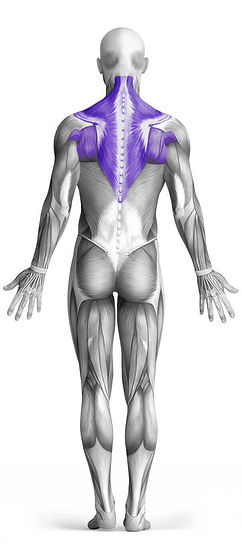Trap Bar Row 101 Video Tutorial
0

Exercise Synopsis
Target Muscle Group
Upper Back
Secondary Targets
Abs, Biceps, Lats, Lower Back
Execution
Compound
Force Type
Pull (Bilateral)
Required Equipment
Trap Bar
Fitness Level
Beginner
Variations
None
Alternatives
None
Timer
Hour
Minute
Second
Stopwatch
00:00:00:00
Overview
The Trap Bar Row is a compound exercise primarily targeting the upper back, while also engaging the abs, biceps, lats, and lower back. It is performed using a trap bar, which allows for a more neutral grip compared to traditional barbell rows, reducing strain on the wrists and shoulders. The movement involves pulling the bar towards your torso while maintaining a strong, stable posture, emphasizing upper back engagement. This exercise is effective for improving overall back strength, posture, and grip strength, while also offering a safer alternative for those with shoulder or wrist discomfort.
How to Perform
Stand inside the trap bar with your feet shoulder-width apart and hinge forward at your hips, keeping your torso slightly above parallel to the floor.
Grip the handles of the trap bar with a neutral grip, ensuring your hands are positioned comfortably at your sides.
Begin the movement by pulling your elbows back and squeezing your shoulder blades together, driving them down toward your back.
Continue pulling the bar towards your lower abdomen, fully contracting the muscles of your upper back (especially the traps, rhomboids, and rear deltoids).
Once you have reached full contraction, slowly lower the bar back down to the starting position, maintaining control of the movement throughout.
Repeat for the desired number of reps, focusing on form and a controlled tempo to maximize muscle engagement and minimize the risk of injury.
★ Bonus: For exercises that involve external weights (such as dumbbells, barbells, or machines), the One Rep Max (1RM) calculator can help you estimate your maximum lifting capacity. Use it to track your strength progress and adjust your training for optimal results.
Tips
Experiment with different head positions during the trap bar row, such as looking forward or tucking your chin, to determine which feels most comfortable and effective for your neck alignment.
Maintain slight tension in your abdominal muscles while pulling the bar toward your body. This will help stabilize your spine and prevent excessive arching or strain on your lower back.
Avoid using momentum to complete the movement. Focus on controlled, deliberate movements throughout each repetition to ensure you are properly engaging the target muscles.
If you notice your biceps becoming overactive and your upper back not fully engaging, try using a false grip (thumbs placed alongside the fingers, not wrapped around the bar) to reduce bicep involvement and emphasize back muscle activation.
Keep your head neutral throughout the exercise. Avoid letting it jut forward as you pull, as this can create unnecessary strain on your neck.
Ensure that your shoulder blades move smoothly along your ribcage during the row. Don't focus solely on the movement of your arms; instead, actively retract the shoulder blades to fully engage the upper back muscles, preventing excessive movement at the shoulder joint.
How Not to Perform
Avoid Arching the Lower Back: Do not let your lower back excessively arch during the movement. This can place unnecessary strain on the spine and lead to injury. Keep your core engaged to support your back and maintain a neutral spine throughout the exercise.
Don’t Use Momentum: Avoid jerking the bar up with your body or swinging to generate momentum. This takes the focus off your upper back and wastes energy. Instead, focus on controlled, smooth movements using your back muscles to pull the bar.
Do Not Overextend the Elbows: Avoid locking your elbows at the top of the movement. Overextending can reduce muscle engagement and may strain the elbow joint. Keep your elbows slightly bent and ensure the focus remains on your upper back and lats.
Don’t Pull with Your Biceps: Avoid using your biceps too much by not relying on your arms to complete the row. If you feel your biceps working more than your upper back, try using a false grip (thumb alongside the fingers) to reduce bicep involvement and better target the back muscles.
Avoid Letting the Head Jut Forward: Keep your neck in a neutral position throughout the exercise. Do not allow your head to jut forward, as this can create strain on the neck and misalign your spine, reducing the effectiveness of the row.
Don’t Neglect Shoulder Blade Retraction: Avoid focusing only on pulling with your arms. Ensure you actively retract your shoulder blades as you pull the bar, rather than just moving your arms. This will properly engage your upper back muscles and prevent the movement from being overly arm-dominant.
Avoid Hyperextending the Hips: Do not push your hips too far forward during the pull. This can cause excessive arching of the lower back and shift focus away from your upper back. Keep your hips in line with your torso to maintain focus on the target muscle group.
Don’t Use an Incorrect Grip: Avoid using a grip that feels uncomfortable or unnatural. If necessary, adjust your hand placement on the trap bar to ensure a neutral grip that minimizes strain on your wrists and shoulders.
Variations
Variations of fitness exercises refer to different ways of performing a specific exercise or movement to target various muscle groups, intensities, or goals. These variations aim to challenge the body differently, prevent plateaus, and cater to individuals with varying fitness levels.
Alternatives
Alternative exercises in fitness refer to different movements or activities that target similar muscle groups or serve the same training purpose as the primary exercise. These alternative exercises can be used as substitutes when the original exercise is unavailable or challenging to perform due to various reasons such as equipment limitations, injuries, or personal preferences.








